Livelihood assets:
A livelihood strategy for small fishers and fisherman laborers in Ternate City
DOI:
https://doi.org/10.52046/agrikan.v14i2.870Keywords:
Modal nafkah, nelayan kecil, buruh nelayan, perubahan iklim, Kota TernateAbstract
This study aims to describe living capital used by small fishermen households and fishing workers in Ternate City. The study results indicate that there are various ways that both small fishermen and fishing laborers use their livelihood strategies through their livelihood capital. In fishermen's labor households, the highest utilization of livelihood capital includes natural capital in the high category, namely 50%, human capital in the medium category (87.50%), physical capital in the medium category (56.50%), financial capital in the medium category (68, 50%). 75%), and low category social capital (87.50%). While for small fishers, natural capital is in the high category (71.91%), human capital is in the medium category (62.92%), physical capital is in the medium category (84.27%), financial capital is in the medium category (65.17%), and financial capital is in the medium category low social category (70.79%). It can be concluded that the use of livelihood capital for both fishermen and small fishers is moderate primarily. In contrast, the high utilization of natural capital indicates that fishers and small fishermen have high access to fishery resources and continue to go to the sea despite extreme weather or climate conditions.
Downloads
Published
Issue
Section
License
Copyright (c) 2021 Fajria Dewi Salim, Sri Endah Widyanti

This work is licensed under a Creative Commons Attribution 4.0 International License.

This work is licensed under a Creative Commons Attribution 4.0 International License.













